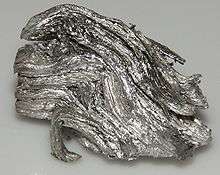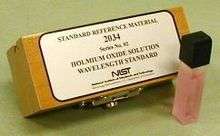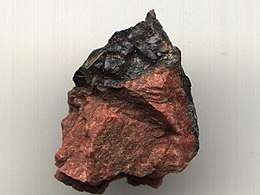Holmium
Holmium is a chemical element with the symbol Ho and atomic number 67. Part of the lanthanide series, holmium is a rare-earth element.
 | |||||||||||||||||||||||||||||||
| Holmium | |||||||||||||||||||||||||||||||
|---|---|---|---|---|---|---|---|---|---|---|---|---|---|---|---|---|---|---|---|---|---|---|---|---|---|---|---|---|---|---|---|
| Pronunciation | /ˈhoʊlmiəm/ | ||||||||||||||||||||||||||||||
| Appearance | silvery white | ||||||||||||||||||||||||||||||
| Standard atomic weight Ar, std(Ho) | 164.930328(7)[1] | ||||||||||||||||||||||||||||||
| Holmium in the periodic table | |||||||||||||||||||||||||||||||
| |||||||||||||||||||||||||||||||
| Atomic number (Z) | 67 | ||||||||||||||||||||||||||||||
| Group | group n/a | ||||||||||||||||||||||||||||||
| Period | period 6 | ||||||||||||||||||||||||||||||
| Block | f-block | ||||||||||||||||||||||||||||||
| Element category | Lanthanide | ||||||||||||||||||||||||||||||
| Electron configuration | [Xe] 4f11 6s2 | ||||||||||||||||||||||||||||||
| Electrons per shell | 2, 8, 18, 29, 8, 2 | ||||||||||||||||||||||||||||||
| Physical properties | |||||||||||||||||||||||||||||||
| Phase at STP | solid | ||||||||||||||||||||||||||||||
| Melting point | 1734 K (1461 °C, 2662 °F) | ||||||||||||||||||||||||||||||
| Boiling point | 2873 K (2600 °C, 4712 °F) | ||||||||||||||||||||||||||||||
| Density (near r.t.) | 8.79 g/cm3 | ||||||||||||||||||||||||||||||
| when liquid (at m.p.) | 8.34 g/cm3 | ||||||||||||||||||||||||||||||
| Heat of fusion | 17.0 kJ/mol | ||||||||||||||||||||||||||||||
| Heat of vaporization | 251 kJ/mol | ||||||||||||||||||||||||||||||
| Molar heat capacity | 27.15 J/(mol·K) | ||||||||||||||||||||||||||||||
Vapor pressure
| |||||||||||||||||||||||||||||||
| Atomic properties | |||||||||||||||||||||||||||||||
| Oxidation states | 0,[2] +1, +2, +3 (a basic oxide) | ||||||||||||||||||||||||||||||
| Electronegativity | Pauling scale: 1.23 | ||||||||||||||||||||||||||||||
| Ionization energies |
| ||||||||||||||||||||||||||||||
| Atomic radius | empirical: 176 pm | ||||||||||||||||||||||||||||||
| Covalent radius | 192±7 pm | ||||||||||||||||||||||||||||||
Color lines in a spectral range | |||||||||||||||||||||||||||||||
| Other properties | |||||||||||||||||||||||||||||||
| Natural occurrence | primordial | ||||||||||||||||||||||||||||||
| Crystal structure | hexagonal close-packed (hcp) | ||||||||||||||||||||||||||||||
| Speed of sound thin rod | 2760 m/s (at 20 °C) | ||||||||||||||||||||||||||||||
| Thermal expansion | poly: 11.2 µm/(m·K) (at r.t.) | ||||||||||||||||||||||||||||||
| Thermal conductivity | 16.2 W/(m·K) | ||||||||||||||||||||||||||||||
| Electrical resistivity | poly: 814 nΩ·m (at r.t.) | ||||||||||||||||||||||||||||||
| Magnetic ordering | paramagnetic | ||||||||||||||||||||||||||||||
| Young's modulus | 64.8 GPa | ||||||||||||||||||||||||||||||
| Shear modulus | 26.3 GPa | ||||||||||||||||||||||||||||||
| Bulk modulus | 40.2 GPa | ||||||||||||||||||||||||||||||
| Poisson ratio | 0.231 | ||||||||||||||||||||||||||||||
| Vickers hardness | 410–600 MPa | ||||||||||||||||||||||||||||||
| Brinell hardness | 500–1250 MPa | ||||||||||||||||||||||||||||||
| CAS Number | 7440-60-0 | ||||||||||||||||||||||||||||||
| History | |||||||||||||||||||||||||||||||
| Discovery | Jacques-Louis Soret and Marc Delafontaine (1878) | ||||||||||||||||||||||||||||||
| Main isotopes of holmium | |||||||||||||||||||||||||||||||
| |||||||||||||||||||||||||||||||
Holmium was discovered through isolation by Swedish chemist Per Theodor Cleve and independently by Jacques-Louis Soret and Marc Delafontaine who observed it spectroscopically in 1878. Its oxide was first isolated from rare-earth ores by Cleve in 1878. The element's name comes from Holmia, the Latin name for the city of Stockholm.[3][4][5]
Elemental holmium is a relatively soft and malleable silvery-white metal. It is too reactive to be found uncombined in nature, but when isolated, is relatively stable in dry air at room temperature. However, it reacts with water and corrodes readily and also burns in air when heated.
Holmium is found in the minerals monazite and gadolinite and is usually commercially extracted from monazite using ion-exchange techniques. Its compounds in nature and in nearly all of its laboratory chemistry are trivalently oxidized, containing Ho(III) ions. Trivalent holmium ions have fluorescent properties similar to many other rare-earth ions (while yielding their own set of unique emission light lines), and thus are used in the same way as some other rare earths in certain laser and glass-colorant applications.
Holmium has the highest magnetic permeability of any element and therefore is used for the polepieces of the strongest static magnets. Because holmium strongly absorbs neutrons, it is also used as a burnable poison in nuclear reactors.
Characteristics
Physical properties
_oxide.jpg)
Holmium is a relatively soft and malleable element that is fairly corrosion-resistant and stable in dry air at standard temperature and pressure. In moist air and at higher temperatures, however, it quickly oxidizes, forming a yellowish oxide. In pure form, holmium possesses a metallic, bright silvery luster.
Holmium oxide has some fairly dramatic color changes depending on the lighting conditions. In daylight, it has a tannish yellow color. Under trichromatic light, it is fiery orange-red, almost indistinguishable from the appearance of erbium oxide under the same lighting conditions. The perceived color change is related to the sharp absorption bands of holmium interacting with a subset of the sharp emission bands of the trivalent ions of europium and terbium, acting as phosphors.[6]
Holmium has the highest magnetic moment (10.6 µ
B) of any naturally occurring element and possesses other unusual magnetic properties. When combined with yttrium, it forms highly magnetic compounds.[7] Holmium is paramagnetic at ambient conditions, but is ferromagnetic at temperatures below 19 K.[8]
Chemical properties
Holmium metal tarnishes slowly in air and burns readily to form holmium(III) oxide:
- 4 Ho + 3 O2 → 2 Ho2O3
Holmium is quite electropositive and is generally trivalent. It reacts slowly with cold water and quite quickly with hot water to form holmium hydroxide:
- 2 Ho (s) + 6 H2O (l) → 2 Ho(OH)3 (aq) + 3 H2 (g)
Holmium metal reacts with all the halogens:
- 2 Ho (s) + 3 F2 (g) → 2 HoF3 (s) [pink]
- 2 Ho (s) + 3 Cl2 (g) → 2 HoCl3 (s) [yellow]
- 2 Ho (s) + 3 Br2 (g) → 2 HoBr3 (s) [yellow]
- 2 Ho (s) + 3 I2 (g) → 2 HoI3 (s) [yellow]
Holmium dissolves readily in dilute sulfuric acid to form solutions containing the yellow Ho(III) ions, which exist as a [Ho(OH2)9]3+ complexes:[9]
- 2 Ho (s) + 3 H2SO4 (aq) → 2 Ho3+ (aq) + 3 SO2−
4 (aq) + 3 H2 (g)
Holmium's most common oxidation state is +3. Holmium in solution is in the form of Ho3+ surrounded by nine molecules of water. Holmium dissolves in acids.[10]
Isotopes
Natural holmium contains one stable isotope, holmium-165. Some synthetic radioactive isotopes are known; the most stable one is holmium-163, with a half-life of 4570 years. All other radioisotopes have ground-state half-lives not greater than 1.117 days, and most have half-lives under 3 hours. However, the metastable 166m1Ho has a half-life of around 1200 years because of its high spin. This fact, combined with a high excitation energy resulting in a particularly rich spectrum of decay gamma rays produced when the metastable state de-excites, makes this isotope useful in nuclear physics experiments as a means for calibrating energy responses and intrinsic efficiencies of gamma ray spectrometers.
History
Holmium (Holmia, Latin name for Stockholm) was discovered by Jacques-Louis Soret and Marc Delafontaine in 1878 who noticed the aberrant spectrographic absorption bands of the then-unknown element (they called it "Element X").[11][12]
As well, Per Teodor Cleve independently discovered the element while he was working on erbia earth (erbium oxide), and was the first to isolate it.[4][3][13][14][15]
Using the method developed by Carl Gustaf Mosander, Cleve first removed all of the known contaminants from erbia. The result of that effort was two new materials, one brown and one green. He named the brown substance holmia (after the Latin name for Cleve's home town, Stockholm) and the green one thulia. Holmia was later found to be the holmium oxide, and thulia was thulium oxide.[16]
In Henry Moseley's classic paper[17] on atomic numbers, holmium was assigned an atomic number of 66. Evidently, the holmium preparation he had been given to investigate had been grossly impure, dominated by neighboring (and unplotted) dysprosium. He would have seen x-ray emission lines for both elements, but assumed that the dominant ones belonged to holmium, instead of the dysprosium impurity.
Occurrence and production
Like all other rare earths, holmium is not naturally found as a free element. It does occur combined with other elements in gadolinite (the black part of the specimen illustrated to the right), monazite and other rare-earth minerals. No holmium-dominant mineral has yet been found.[18] The main mining areas are China, United States, Brazil, India, Sri Lanka, and Australia with reserves of holmium estimated as 400,000 tonnes.[16]
Holmium makes up 1.4 parts per million of the Earth's crust by mass. This makes it the 56th most abundant element in the Earth's crust. Holmium makes up 1 part per million of the soils, 400 parts per quadrillion of seawater, and almost none of Earth's atmosphere. Holmium is rare for a lanthanide.[19] It makes up 500 parts per trillion of the universe by mass.[20]
It is commercially extracted by ion exchange from monazite sand (0.05% holmium), but is still difficult to separate from other rare earths. The element has been isolated through the reduction of its anhydrous chloride or fluoride with metallic calcium.[21] Its estimated abundance in the Earth's crust is 1.3 mg/kg. Holmium obeys the Oddo–Harkins rule: as an odd-numbered element, it is less abundant than its immediate even-numbered neighbors, dysprosium and erbium. However, it is the most abundant of the odd-numbered heavy lanthanides. The principal current source are some of the ion-adsorption clays of southern China. Some of these have a rare-earth composition similar to that found in xenotime or gadolinite. Yttrium makes up about 2/3 of the total by mass; holmium is around 1.5%. The original ores themselves are very lean, maybe only 0.1% total lanthanide, but are easily extracted.[22] Holmium is relatively inexpensive for a rare-earth metal with the price about 1000 USD/kg.[23]
Applications

Holmium has the highest magnetic strength of any element, and therefore is used to create the strongest artificially generated magnetic fields, when placed within high-strength magnets as a magnetic pole piece (also called a magnetic flux concentrator).[24] Since it can absorb nuclear fission-bred neutrons, it is also used as a burnable poison to regulate nuclear reactors.[16]
Holmium-doped yttrium iron garnet (YIG) and yttrium lithium fluoride (YLF) have applications in solid-state lasers, and Ho-YIG has applications in optical isolators and in microwave equipment (e.g., YIG spheres). Holmium lasers emit at 2.1 micrometres.[25] They are used in medical, dental, and fiber-optical applications.[7]
Holmium is one of the colorants used for cubic zirconia and glass, providing yellow or red coloring.[26] Glass containing holmium oxide and holmium oxide solutions (usually in perchloric acid) have sharp optical absorption peaks in the spectral range 200–900 nm. They are therefore used as a calibration standard for optical spectrophotometers[27] and are available commercially.[28]
The radioactive but long-lived 166m1Ho (see "Isotopes" above) is used in calibration of gamma-ray spectrometers.[29]
In March 2017, IBM announced that they had developed a technique to store one bit of data on a single holmium atom set on a bed of magnesium oxide.[30]
With sufficient quantum and classical control techniques, Ho could be a good candidate to make quantum computers.[31]
Biological role
Holmium plays no biological role in humans, but its salts are able to stimulate metabolism.[21] Humans typically consume about a milligram of holmium a year. Plants do not readily take up holmium from the soil. Some vegetables have had their holmium content measured, and it amounted to 100 parts per trillion.[10]
Toxicity
Large amounts of holmium salts can cause severe damage if inhaled, consumed orally, or injected. The biological effects of holmium over a long period of time are not known. Holmium has a low level of acute toxicity.[32]
See also
- Holmium compounds
References
- Meija, Juris; et al. (2016). "Atomic weights of the elements 2013 (IUPAC Technical Report)". Pure and Applied Chemistry. 88 (3): 265–91. doi:10.1515/pac-2015-0305.
- Yttrium and all lanthanides except Ce, Pm, Eu, Tm, Yb have been observed in the oxidation state 0 in bis(1,3,5-tri-t-butylbenzene) complexes, see Cloke, F. Geoffrey N. (1993). "Zero Oxidation State Compounds of Scandium, Yttrium, and the Lanthanides". Chem. Soc. Rev. 22: 17–24. doi:10.1039/CS9932200017.
- Marshall, James L. Marshall; Marshall, Virginia R. Marshall (2015). "Rediscovery of the elements: The Rare Earths–The Confusing Years" (PDF). The Hexagon: 72–77. Retrieved 30 December 2019.
- "Holmium". Royal Society of Chemistry. 2020. Retrieved 4 January 2020.
- Stwertka, Albert (1998). A guide to the elements (2nd ed.). Oxford University Press. p. 161. ISBN 0-19-508083-1.
- Yiguo Su; Li, Guangshe; Chen, Xiaobo; Liu, Junjie; Li, Liping (2008). "Hydrothermal Synthesis of GdVO4:Ho3+ Nanorods with a Novel White-light Emission". Chemistry Letters. 37 (7): 762–763. doi:10.1246/cl.2008.762.
- C. K. Gupta; Nagaiyar Krishnamurthy (2004). Extractive metallurgy of rare earths. CRC Press. p. 32. ISBN 0-415-33340-7.
- Jiles, David (1998). Introduction to magnetism and magnetic materials. CRC Press. p. 228. ISBN 0-412-79860-3.
- "Chemical reactions of Holmium". Webelements. Retrieved 2009-06-06.
- Emsley, John (2011). Nature's Building Blocks.
- Jacques-Louis Soret (1878). "Sur les spectres d'absorption ultra-violets des terres de la gadolinite". Comptes rendus de l'Académie des sciences. 87: 1062.
- Jacques-Louis Soret (1879). "Sur le spectre des terres faisant partie du groupe de l'yttria". Comptes rendus de l'Académie des sciences. 89: 521.
- Weeks, Mary Elvira (1956). The discovery of the elements (6th ed.). Easton, PA: Journal of Chemical Education.
- Per Teodor Cleve (1879). "Sur deux nouveaux éléments dans l'erbine". Comptes rendus de l'Académie des sciences. 89: 478–480. Cleve named holmium on p. 480: "Je propose pour ce métal le nom de holmium, Ho, dérivé du nom latinisé de Stockholm, dont les environs renferment tant de minéraux riches en yttria." (I propose for this metal the name of "holmium", Ho, [which is] derived from the Latin name for Stockholm, the environs of which contain so many minerals rich in yttrium.)
- Per Teodor Cleve (1879). "Sur l'erbine". Comptes rendus de l'Académie des sciences. 89: 708.
- John Emsley (2001). Nature's building blocks: an A-Z guide to the elements. US: Oxford University Press. pp. 181–182. ISBN 0-19-850341-5.
- Moseley, H.G.J. (1913). "The high-frequency spectra of the elements". Philosophical Magazine. 6th series. 26: 1024–1034.
- Hudson Institute of Mineralogy (1993–2018). "Mindat.org". www.mindat.org. Retrieved 14 January 2018.
- Emsley, John (2011). Nature's Building Blocks. Oxford University Press.
- Ltd, Mark Winter, University of Sheffield and WebElements. "WebElements Periodic Table » Periodicity » Abundance in the universe » periodicity". www.webelements.com. Archived from the original on 2017-09-29. Retrieved 27 March 2018.
- C. R. Hammond (2000). The Elements, in Handbook of Chemistry and Physics (81st ed.). CRC press. ISBN 0-8493-0481-4.
- Patnaik, Pradyot (2003). Handbook of Inorganic Chemical Compounds. McGraw-Hill. pp. 338–339. ISBN 0-07-049439-8. Retrieved 2009-06-06.
- James B. Hedrick. "Rare-Earth Metals" (PDF). USGS. Retrieved 2009-06-06.
- R. W. Hoard; S. C. Mance; R. L. Leber; E. N. Dalder; M. R. Chaplin; K. Blair; et al. (1985). "Field enhancement of a 12.5-T magnet using holmium poles". IEEE Transactions on Magnetics. 21 (2): 448–450. Bibcode:1985ITM....21..448H. doi:10.1109/tmag.1985.1063692.
- Wollin, T. A.; Denstedt, J. D. (Feb 1998). "The holmium laser in urology". Journal of Clinical Laser Medicine & Surgery. 16 (1): 13–20. doi:10.1089/clm.1998.16.13. PMID 9728125.
- "Cubic zirconia". Archived from the original on 2009-04-24. Retrieved 2009-06-06.
- R. P. MacDonald (1964). "Uses for a Holmium Oxide Filter in Spectrophotometry" (PDF). Clinical Chemistry. 10 (12): 1117–20. PMID 14240747.
- "Holmium Glass Filter for Spectrophotometer Calibration". Archived from the original on 2010-03-14. Retrieved 2009-06-06.
- Ming-Chen Yuan; Jeng-Hung Lee & Wen-Song Hwang (2002). "The absolute counting of 166mHo, 58Co and 88Y". Applied Radiation and Isotopes. 56 (1–2): 429–434. doi:10.1016/S0969-8043(01)00226-3. PMID 11839051.
- Coldeway, Devin (March 9, 2017). "Storing data in a single atom proved possible by IBM researchers". TechCrunch. Retrieved 2017-03-10.
- Forrester, Patrick Robert; Patthey, François; Fernandes, Edgar; Sblendorio, Dante Phillipe; Brune, Harald; Natterer, Fabian Donat (2019-11-19). "Quantum state manipulation of single atom magnets using the hyperfine interaction". Physical Review B. 100 (18): 180405. Bibcode:2019PhRvB.100r0405F. doi:10.1103/PhysRevB.100.180405. ISSN 2469-9950.
- "Holmium" in Periodic Table v2.5. University of Coimbra, Portugal
External links
| Wikimedia Commons has media related to Holmium. |
| Look up holmium in Wiktionary, the free dictionary. |
- WebElements.com – Holmium (also used as a reference)
- American Elements – Holmium American Elements (also used as a reference)
- Holmium at The Periodic Table of Videos (University of Nottingham)
